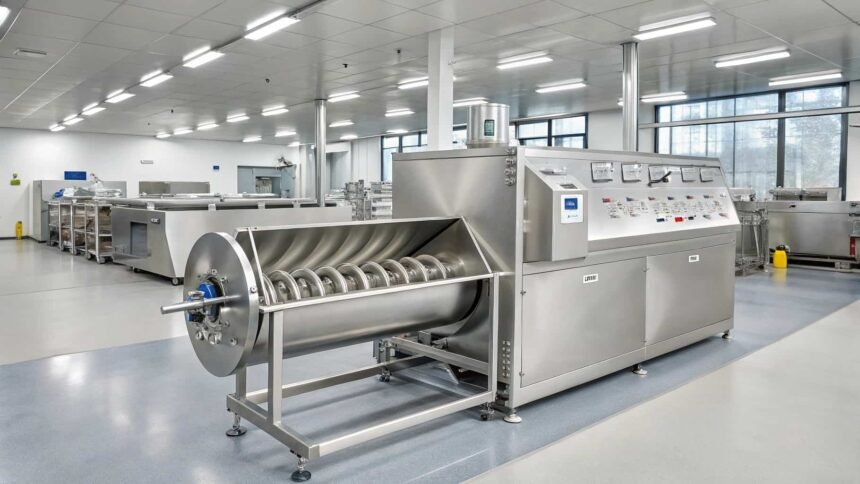In industries where blending dry powders or semi-wet ingredients is a daily affair, ribbon mixers have become an indispensable part of the manufacturing process. These machines are trusted for their precision, speed, and reliability in achieving homogenous blends. Whether you’re in food processing, pharmaceuticals, or chemical manufacturing, ribbon mixers have likely touched some part of the production line.
What Is a Ribbon Mixer?
A ribbon mixer is a type of industrial mixing equipment known for its long trough-like design and unique agitator consisting of inner and outer helical ribbons. These ribbons rotate in opposite directions to ensure that materials are thoroughly mixed. Its horizontal configuration and consistent motion make it ideal for blending powders, granules, and even some wet materials.
Types of Ribbon Mixers
There are two main types of ribbon mixers: single ribbon and double ribbon. The single ribbon has one helical blade that pushes materials in one direction, while the double ribbon includes a set of inner and outer ribbons that move materials both inward and outward simultaneously. This bidirectional movement greatly improves mixing efficiency and uniformity.
How Ribbon Mixers Work
The Mixing Mechanism
Ribbon mixers rely on a countercurrent flow mechanism. As the inner ribbon moves ingredients toward the center, the outer ribbon pushes them outward. This opposing action creates a continuous loop of material flow that ensures even blending. The rotation speed, typically moderate, is optimized to minimize damage to fragile materials while ensuring a consistent mix. The design is straightforward: a U-shaped horizontal trough houses a shaft with helical ribbons. The shaft is powered by an electric motor and gearbox, which allows the blades to rotate.
Key Components of a Ribbon Mixer
Horizontal Trough: This is the main chamber where ingredients are loaded. It’s designed to withstand heavy-duty use and is typically made from stainless steel or mild steel based on the industry requirements.
Ribbon Agitator: The agitator consists of two helical ribbons—one inner and one outer—mounted on a common shaft. The spacing and angle of these ribbons are engineered to move material efficiently throughout the entire volume of the mixer.
Motor and Drive System: The motor is the heart of the ribbon mixer. It powers the shaft that rotates the ribbons. Many modern ribbon mixers use variable frequency drives (VFDs) to allow operators to adjust mixing speeds according to the nature of the materials.
Common Applications of Ribbon Mixers
Food Industry: Ribbon mixers are widely used to blend flour, baking powders, spices, and other dry ingredients. They’re also used in ready-to-eat meals and pet food processing, especially when light moisture needs to be added during blending.
Pharmaceuticals: In the pharmaceutical industry, ribbon mixers help in the uniform mixing of bulk powders for tablet production or nutritional supplements, where precision and hygiene are paramount.
Chemicals and Fertilizers: For chemicals, pigments, and fertilizers, these mixers ensure that all ingredients are distributed evenly, improving product quality and reducing waste due to inconsistencies.
Benefits of Using Ribbon Mixers
Ribbon mixers are designed to complete mixes in relatively short cycles. Their helical ribbons ensure thorough blending in just minutes, making them suitable for high-output facilities. The design ensures every particle is evenly distributed, which is especially important when ingredients have different sizes, densities, or flow properties. From dry to moist materials, ribbon mixers handle a wide range of substances. They can also accommodate heat-sensitive or fragile items without breaking them apart.
Limitations of Ribbon Mixers
Despite their many benefits, ribbon mixers aren’t ideal for all applications. They may not be suitable for highly viscous materials or where extreme precision in mixing tiny quantities is required. Additionally, cleaning them thoroughly between batches can be time-consuming if not properly designed.
Comparison with Other Mixers
Paddle mixers move ingredients more gently and are preferred for mixing fragile or irregularly shaped materials. Ribbon mixers, on the other hand, provide more aggressive blending suitable for fine powders and granules. Planetary mixers are better suited for small batches and viscous materials like doughs or pastes, whereas ribbon mixers are designed for high-volume production of dry or slightly moist products.
Design Considerations When Choosing a Ribbon Mixer
Batch Size: Choose a mixer based on the batch size you typically handle. Oversized mixers may lead to inefficient blending, while undersized ones can result in production delays.
Mixing Time: Different products require different mixing durations. Ribbon mixers with adjustable speed controls allow fine-tuning of the mixing time.
Product Characteristics: Some materials are free-flowing, while others are sticky or prone to clumping. Understanding your product’s behavior helps in selecting the right ribbon design and mixing speed.
Cleaning and Maintenance
Modern ribbon mixers are designed with removable covers, hinged access doors, and clean-out doors to simplify cleaning. Some models support Clean-In-Place (CIP) systems that automate cleaning using water or solvents. Others require manual scrubbing, which can be labor-intensive if the design isn’t optimized.
Safety Features and Standards
Top-tier ribbon mixers include safety interlocks, emergency stop buttons, and explosion-proof motors if dealing with flammable substances. Compliance with standards like CE, UL, or GMP is essential, especially in food and pharma sectors.
Cost Factors and ROI
Ribbon mixers vary in cost based on size, materials, and additional features. While the initial investment might be significant, the long-term return in efficiency, product consistency, and reduced labor often justifies the price.
Latest Innovations in Ribbon Mixers
Automation is the buzzword in industrial mixing today. Many ribbon mixers now come with programmable logic controllers (PLCs), smart sensors, and integration options for Industry 4.0, enabling real-time monitoring and better quality control.
Tips for Optimal Performance
Avoid overloading the mixer and always ensure the materials are added in the correct sequence. Routine maintenance, including lubrication and inspection, prolongs equipment life and prevents downtime.
Future Outlook of Ribbon Mixer Technology
As industries demand faster, cleaner, and more energy-efficient operations, ribbon mixers are being redesigned for better sealing, lower energy consumption, and integration with automated lines. With the rise of customized mixing solutions, their future looks promising across many sectors.
Conclusion
Ribbon mixers have earned their place in the industrial mixing world through consistent performance, versatility, and ease of use. Whether you’re dealing with powders, granules, or light pastes, they provide a balanced solution that caters to diverse applications. As technology advances, these mixers are only becoming more efficient and smarter, making them a worthy investment for businesses aiming for high-quality outputs.








